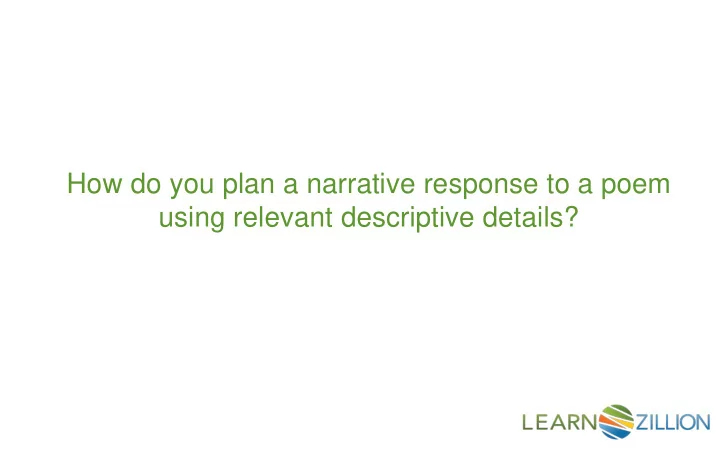

How do you plan a narrative response to a poem using relevant descriptive details?
In this lesson you will learn how to plan an imagined narrative reading response by applying relevant descriptive details of the narrator, character and setting.
Let’s Review Write a poem in response to Emily Dickinson’s “The Wind’s Visit”, where the narrator is the wind. Your poem should describe a second visit between the two characters, from the wind’s point of view. The poem should be brief, like Dickinson’s. Your poem should “pick up” where “The Wind’s Visit” left off and your word choice and description should let the reader know how the wind feels or reacts to this visit. Your poem should describe the visit completely, so that the reader has the sense of conclusion by the poem’s end.
Let’s Review Writing Process 1 2 3 4 Read Generate Draft & Edit & closely & & plan revise publish analyze Write a poem in response to “The Wind’s Visit”, where the wind is the narrator.
“The Wind’s Visit” Let’s Review by Emily Dickinson The Wind’s Visit • Narrator “visited” by the character the wind The wind tapped like a tired man, And like a host, “Come in,” • The visit is not long I boldly answered; entered then My residence within A rapid, footless guest, • Poems have abbreviated To offer whom a chair description Were as impossible as hand A sofa to the air. No bone had he to bind him, • Narrator, character, setting His speech was like the push descriptions revealed through Of numerous humming-birds at once details From a superior bush.
Core Lesson Reread the text, highlighting details that 1 describe the narrator, character(s) and setting. Ask, “What relevant descriptive details will I 2 need to include or add to these?” Jot these down. Ask, “How will I add to these descriptions in a 3 new situation?” Add these to the list.
Reread the text, highlighting details that Core Lesson describe the narrator, character(s) and setting. The Wind’s Visit The wind tapped like a tired man, • Narrator: blue And like a host, “Come in,” I boldly answered; entered then • Character: green My residence within A rapid, footless guest, To offer whom a chair • Setting: yellow Were as impossible as hand A sofa to the air. No bone had he to bind him, His speech was like the push Of numerous humming-birds at once From a superior bush.
Reread the text, highlighting details that Core Lesson describe the narrator, character(s) and setting. His countenance a billow, His fingers, if he pass, • Narrator: blue Let go a music, as of tunes Blown tremulous in glass. He visited, still flitting; • Character: green Then, like a timid man, Again he tapped — 't was flurriedly — • Setting: yellow And I became alone. Emily Dickinson
Ask, “What relevant descriptive details will I Core Lesson need to include or add to these?” Jot these down. • • Wind: countenance a billow • • tired man, timid man his fingers let go music • • rapid, footless guest still flitting • • no bones to bind him tapped flurriedly • Do I need to add speech like push of more relevant numerous h-bs description? • superior
Ask, “What relevant descriptive details will I Core Lesson need to include or add to these?” Jot these down. • • Narrator/Woman: Setting: • • like a host my residence within • • boldly answered chair • • became alone visit Do I need to add more relevant description?
Ask, “What relevant descriptive details will I Core Lesson need to include or add to these?” Jot these down. What description do I need to add to these? • • Narrator/Woman: Setting: • • like a host my residence within • • boldly answered chair • • became alone visit
Ask, “What relevant descriptive details will I Core Lesson need to include or add to these?” Jot these down. • her movement(s)/dress Narrator/Woman: like a host • what she said/did boldly answered became alone • her reaction to him/visit Setting: my residence within • when & where (2 nd visit) chair visit • room description
Ask, “How will I add to these Core Lesson descriptions in a new situation?” storms, halts, meet my gaze • her movement(s)/dress inches, perches like sparrow shivers, reached, leaps muslin “Who’s there?”, “Please stay” “Why have you come back?” • what she said/did no knock, whimpers, cowering afraid, trills, detain confused, snared, mute, alone • her reaction to him/visit
Core Lesson Writing Process 1 2 3 4 Read Generate Edit & closely & Draft & & plan publish analyze revise
Ask, “How will I add to these Core Lesson descriptions in a new situation?” • when & where (2 nd mistress’s house, again, now visit) not expecting my return small, close, cell throne, sofa, cooled breeze • room description open door
Core Lesson Reread the text, highlighting details that 1 describe the narrator, character(s) and setting. Ask, “What relevant descriptive details will I 2 need to include or add to these?” Jot these down. Ask, “How will I add to these descriptions in a 3 new situation?” Add these to the list.
In this lesson you have learned how to plan an imagined narrative reading response by applying relevant descriptive details of the narrator, character and setting.
Recommend
More recommend